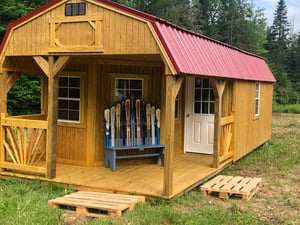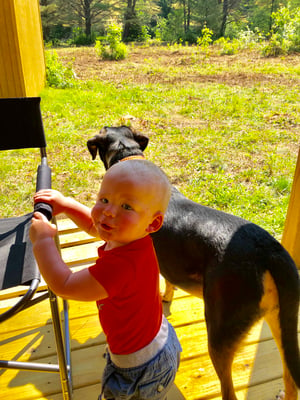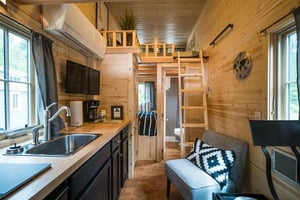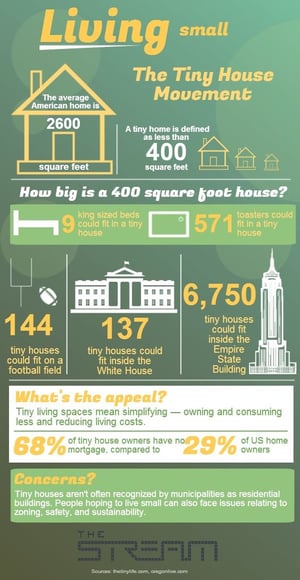 What happens when KLA’s Director of Sustainability Planning walks her sustainability talk...right into a tiny house.
What happens when KLA’s Director of Sustainability Planning walks her sustainability talk...right into a tiny house.
By: Angela Cleveland, AICP
Tiny House. Big Hearts.
I’ve always been committed to living within a small footprint. We buy local. I drive a small, fuel efficient car. We unplug devices in our home when not in use. We always live in repurposed buildings. I investigate the packaging options before purchasing something.
So when my husband said he wanted to purchase 48 acres of land in New Hampshire to build a house, I immediately thought: “How can we make as little of an impact on this property as possible?”
What came next -- a tiny house -- actually happened by accident.
 Our Journey to Tiny Town
Our Journey to Tiny Town
We want to build a regular house, but that’s going to take time and we want to enjoy the property without having to stay in hotel rooms every time we travel north from our home base in Lowell, MA. I have always had an obsession with tiny houses. I love the idea of being efficient and, by all means, a tiny house encourages you to do that. The challenge was to find a house that fits our needs, wasn’t going to break the bank (you should see the cost of some of the tiny houses – you can buy a regular house for the cost of some of them!), and would be constructed locally so we could keep the construction and transportation-related GHG emissions as low as possible and support a local company.
 For months my husband and I trolled websites, searched Facebook Marketplace, and even liked a couple of pages where we thought we might find a winner. Nothing. Then, a eureka moment hit. I was taking a class in Littleton, NH, and kept passing a business that sold barns and had a little house on it with a flag that said “Open”. Every time I went by, I smiled and said, “that house is so cute!” After the bazillionth time passing it, I said to myself, “Angie, THAT’S THE TINY HOUSE!” On our next trip to New Hampshire, we stopped by Old Hickory Buildings and Sheds and bought that house!
For months my husband and I trolled websites, searched Facebook Marketplace, and even liked a couple of pages where we thought we might find a winner. Nothing. Then, a eureka moment hit. I was taking a class in Littleton, NH, and kept passing a business that sold barns and had a little house on it with a flag that said “Open”. Every time I went by, I smiled and said, “that house is so cute!” After the bazillionth time passing it, I said to myself, “Angie, THAT’S THE TINY HOUSE!” On our next trip to New Hampshire, we stopped by Old Hickory Buildings and Sheds and bought that house!
It was constructed in Maine (20 miles away from our property) and delivered by truck to our property in early June. We hired a local contractor to clear the space for the tiny house (mulching only, no tilling or disturbance to the soil). Luckily only a couple of saplings had to be removed to bring it in (which will be repurposed – more on this later), and 3 hours later, our 336 square foot tiny house was installed, leveled and ready to be fitted out. That will involve the following:
- Only secondhand furniture is being used or purchased to furnish the house
- Insulation will be from recycled blue jeans – yes this is a thing!
- Non or low-VOC paints will be used on the walls and ceilings
- Power will be from a Goal-Zero battery charged by a solar panel
- We are constructing an outdoor, solar-powered shower out of pallets
- An outhouse will be installed (is it weird that I am excited about this?!)
- The next round of land clearing will be conducted by goats (the goats were busy for round one. It’s hard to find good goat labor!)
- Flooring will be from sustainable resources: the kitchen has a bamboo floor and the living room and sleeping area has carpet purchased from FLOR, a company that is committed to zero waste
- Trees that were removed during the tiny house delivery will be used for curtain rods and a ladder to access the loft.
The 411 on the Tiny House Movement
The official definition of a tiny house includes any dwelling with 400 square feet or less of floor area. Over 10,000 of these pint-sized abodes exist in the US today, and that number is growing with at least 700 new units built commercially every year. And if Amazon get in on the action with mail-order houses, the sky's the limit! It’s not hard to see why the tiny living trend has taken off in the past decade following the Recession. Living in a tiny house offers an appealing alternative to the grip of an expensive mortgage with sky-high utility bills. Owning a tiny house comes with liberating self-sufficiency: 68% of tiny home owners don’t have any mortgage on their tiny house, and 89% have less credit card debt than the average American.
 In addition to their financial appeal, tiny homes allow for environmental self-sufficiency and a reduced carbon footprint. The average American home increased in size by over 50% from 1973 to 2013, shooting up to 2,598 square feet. That’s a lot of space to heat, cool and power, and all of that energy means more emissions. Tiny houses, on the other hand, usually fall between just 100 and 400 square feet. Reducing a home’s size even by half can result in a 36% decrease in emissions – imagine what downsizing to 400 square feet could do! Plus, tiny living creates opportunities for living off the grid and powering your home with renewable energy, such as solar panels. Even without going tiny, though, the average size of new homes in the US is beginning to trend smaller. Tiny houses are leading the way in a broader shift toward downsizing the way we live.
In addition to their financial appeal, tiny homes allow for environmental self-sufficiency and a reduced carbon footprint. The average American home increased in size by over 50% from 1973 to 2013, shooting up to 2,598 square feet. That’s a lot of space to heat, cool and power, and all of that energy means more emissions. Tiny houses, on the other hand, usually fall between just 100 and 400 square feet. Reducing a home’s size even by half can result in a 36% decrease in emissions – imagine what downsizing to 400 square feet could do! Plus, tiny living creates opportunities for living off the grid and powering your home with renewable energy, such as solar panels. Even without going tiny, though, the average size of new homes in the US is beginning to trend smaller. Tiny houses are leading the way in a broader shift toward downsizing the way we live.
Tip: A great resource for all things tiny is The Tiny Life website.
Tiny houses aren’t just trendy – they’re being mobilized for good in innovative ways across the country.  After Hurricane Katrina, tiny homes called Katrina Cottages were used to provide emergency housing, offering a homier alternative to FEMA-supplied trailers. Mississippi provided 2,800 of these 308-square-foot cottages to those who lost their homes in the hurricane. Elsewhere, tiny house villages have been built to provide affordable housing for people experiencing homelessness. Also known as micro-home communities, these villages have proven successful in Dallas, Detroit, and Portland, OR, among other cities.
After Hurricane Katrina, tiny homes called Katrina Cottages were used to provide emergency housing, offering a homier alternative to FEMA-supplied trailers. Mississippi provided 2,800 of these 308-square-foot cottages to those who lost their homes in the hurricane. Elsewhere, tiny house villages have been built to provide affordable housing for people experiencing homelessness. Also known as micro-home communities, these villages have proven successful in Dallas, Detroit, and Portland, OR, among other cities.
A Smaller House but Bigger Questions
They may be small, but tiny houses are creating big solutions...and helping us ask bigger questions. Our experience has been a great opportunity to think about how to consume less, be creative, and make due with what you have. We are constantly looking at things and asking:
- Is there a dual purpose to buying/obtaining that product?
- What can we reuse to serve the same function as something brand new?
- Can we do without something?
I have found that this experience is challenging me to ask these questions all the time now, not just in relationship to the tiny house. And my favorite part of this is: this will be a valuable lesson for our 1-year old to live with less and appreciate what we have to the fullest extent. Because less really is more!



